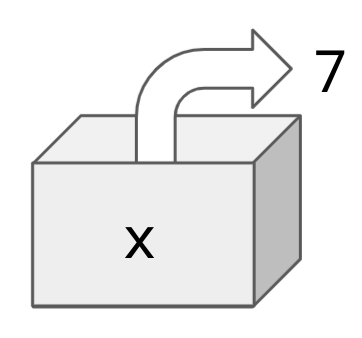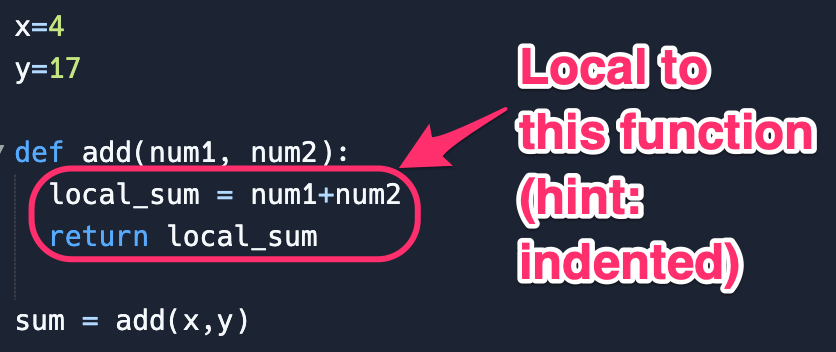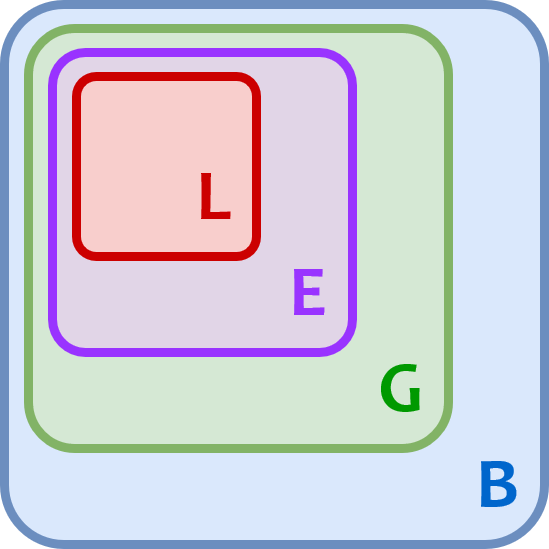Functions
- Press O or Escape for overview mode.
- Visit this link for a nice printable version
- Press the copy icon on the upper right of code blocks to copy the code
Class outline:
Review
Data types & values
Programs manipulate values.
Each value has a certain data type.
| Data type | Example values |
|---|---|
| Integers | 2 44 -3
|
| Floats | 3.14 4.5 -2.0
|
| Booleans | True False
|
| Strings | '¡hola!' 'its python time!'
|
Expressions & operators
Python evaluates expressions into values in one or more steps.
| Expression | Value |
|---|---|
'ahoy'
| 'ahoy'
|
'a' + 'hoy'
| 'ahoy'
|
7 / 2
| 3.5
|
Mathematical operators
| Operator | Name | Example |
|---|---|---|
| + | Addition | 1 + 2 = 3 |
| - | Subtraction | 2 - 1 = 1 |
| * | Multiplication | 2 * 3 = 6 |
| / | Division | 6 / 3 = 2 |
| % | Modulus (divide & return the remainder) | 5 % 2 = 1 |
| ** | Exponentation (aka powers) | 2 ** 3 = 8 |
| // | Floor division (divide & round down to the nearest integer) | 5 // 2 = 2 |

Variables
A name can be bound to a value.
A name that's bound to a data value is also known as a variable.
One way to bind a name is with an assignment statement:
| x | = | 7 |
| Name | Value |
The value can be any expression:
| x | = | 1 + 2 * 3 - 4 // 5 |
| Name | Expression |
Naming conventions for variables & functions
- Use a lowercase single letter (variables only), word, or words
- Separate words with underscores
- Make names meaningful, ex
first_namerather thanfn
Examples
m(variables only)hobbymy_fav_hobby
See more examples at Real Python: https://realpython.com/python-pep8/#naming-styles
Built-in functions
Python has lots of built-in functions. Built-in functions are not specific to a particular data type - they often work on multiple data types (but check the docs!)
Some examples are:
pow(2, 100)
max(50, 300)
min(-1, -300)
Importing functions & modules
Some functions from the Python standard library are available by default. Others are included with a basic Python installation, but need to be imported into your current file before they can be used.
Import a single function from the Operator module :
from operator import add
18 + 69
add(18, 69)
Debugging with print()
One of the most commonly-used built-in functions is print()
We use print() to tell Python what to output to the console. This is very useful in debugging - ex, to see the value of a variable.
print("hello world")
x = 5
y = 10
print(x)
print(y)
print(x+y)
Built-in methods
Each data type has a set of built-in methods that only work on that data type. Check the Python data types docs to see which methods are available for a given data type.
Examples of string methods are:
| Function | Description |
|---|---|
| .upper() | Returns a copy of the string with all characters converted to uppercase |
| .lower() | Returns a copy of the string with all characters converted to lowercase |
| .title() | Returns a titlecased version of the string where words start with an uppercase character and the remaining characters are lowercase |
| .swapcase() | Returns a copy of the string with uppercase characters converted to lowercase and vice versa |
| .strip() | Returns a copy of the string with the leading and trailing whitespace characters removed |
Syntax tips
String syntax
Make sure you wrap strings in quotes. Otherwise Python will think it's the name of a variable or function.
Quotes can be single or double, just be consistent.
| Uh-Oh | Correct |
|---|---|
|
|
|
|
|
|
Comment syntax
A comment is human-readable text that's ignored by the Python interpreter.
# A single-line comment starts with a hash sign
x = 4 # A comment can also go at the end of the line
"""
Multi-line comments
start and end with three quotes.
"""
Commenting out
A common programming practice is to "comment things out" while debugging code. That allows you to see how your program works without a line of code and see whether that affects the execution or fixes a bug.
x = 5
y = 10
#z = x ** y
z = pow(x, y)
Documenting with comments
Programmers often use comments to explain segments of code that aren't obvious.
h = 50 # Hue from 0-360
s = 99 # Saturation from 0-100
v = 50 # Value from 0-100
Functions intro
What is a function?
A function is a sequence of code that performs a particular task and can be easily reused. ♻️
We've already used functions!
add(18, 69)
mul(60, sub(5, 4))
A function takes input(s) (the arguments) and returns an output (the return value).
18, 69 → add → 87
Why functions?
Consider this function-less code:
greeting1 = "Hello, Jackson, how are you?";
greeting2 = "Hello, Dr. Biden, how are you?";
greeting3 = "Hello, Stranger, how are you?";
Functions help when code has repetition.
Function parameters help when that repetitive code has variation.
Building a function
First identify the repetitive parts:
def say_greeting():
return "Hello, how are you?"
Then use parameters for the parts that vary:
def say_greeting(name):
return "Hello, " + name + ", how are you?"
Finally, test it with different arguments:
greeting1 = say_greeting("Jackson");
greeting2 = say_greeting("Dr. Biden")
greeting3 = say_greeting("Stranger")
Defining functions
Defining functions
The most common way to define functions is Python is the def statement.
def <name>(<parameters>):
return <return expression>
Example:
def add(num1, num2):
return num1 + num2
Once defined, we can call it:
add(2, 2)
add(18, 69)
Anatomy of a function definition
The first line is called the function signature, all lines after are considered the function body.
def <name>(<parameters>): # ← Function signature
return <return expression> # ← Function body
def add(num1, num2): # ← Function signature
return num1 + num2 # ← Function body
The function body can have multiple lines:
def add(num1, num2): # ← Function signature
sum = num1 + num2 # ← Function body
return sum # ← Function body
Function arguments
We can pass in any expressions as arguments.
def add(num1, num2):
return num1 + num2
x = 1
y = 2
add(x, y)
x = 3
add(x * x, x + x)
Return values
The return keyword returns a value to whoever calls the function (and exits the function).
def add(num1, num2):
return num1 + num2
sum = add(2, 4)
Reminder: You can use function calls in expressions:
big_sum = add(200, 412) + add(312, 256)
...and nest function calls inside function calls:
huge_sum = add(add(200, 412), add(312, 256))
Spot the bug #1
What's wrong with this code?
def add(num1, num2):
return sum
sum = num1 + num2
sum = add(2, 4)
The code after the return statement will not be executed, that line belongs before the return.
Spot the bug #2
What's wrong with this code?
def add():
return num1 + num2
sum = add(2, 4)
The function body is referring to variables that don't seem to exist. Most likely, they should be parameters in the function signature.
Spot the bug #3
What's wrong with this code?
def add(num1, num2):
sum = num1 + num2
sum = add(2, 4)
The function body does not return any value. However, the code that calls it tries to use the result of the expression. It should have a return statement that returns the sum.
Challenge question
What will happen if we run the following code?
from operator import add
def add(num1, num2):
response = num1 * num2
return response
sum = add(2, 4)
print(sum)
Remember from class 1, names can be reassigned! This is true for both variables and functions. A name will always refer to its last assigned value.
Exercise
Let's work on this together!
Open the Class2Ex1DogAge repl and click Fork repl.
Forking Replit files
- Click the link to the Replit, ex https://replit.com/@lizkrznarich/Class2Ex1DogAge
- Click Fork Replit

- Click Edit in workspace

More on names
Namespaces
Python uses the concept of namespaces to organize the symbolic names assigned to objects, like variables and functions. Namespaces help to avoid name conflicts.
Python has 4 levels of namespaces:
| Built-in | Contains the names of all of Python’s built-in objects (ex, functions like print() and pow()) |
| Global | Contains any names defined at the level of the main program (ie, variable & function names that are NOT indented) |
| Enclosing | When functions are nested, contains names defined inside a parent function (ie, variabl & function names that are indented) |
| Local | Contains names defined inside a function (ie, variable names that are indented) |
Example: Global vs Local names
In practice, we mostly care about whether a name is global or local.
| Global | 
|
| Local | 
|
Name look-up
Multiple namespaces means that multiple variables, functions, etc can have the same name without conflicting, as long as they are in different namespaces.
But how does Python know which namespace to look in?
It follows the LEGB rule!

Name look-up
If your code has a variable named x, Python searches for where x is defined in this order:- Local: If you refer to x inside a function, Python first searches within that function
- Enclosing: If x isn’t in the local namespace but appears in a function that resides inside another function, Python searches in the enclosing function
- Global: If neither of the above searches is fruitful, Python looks in the global namespace
- Built-in: If it can’t find where x is defined anywhere else, Python tries the built-in namespace
If a definition for x isn't found, a name error is thrown
Why do we care about namespaces?
- Avoid name errors
- Make sure we're using the function or variable that we intend to
- Make sure we can access the value of a variable/function where it's needed
Example: Multiple functions with the same name
# this calls pow() from the built-in namespace
print(pow(3,4))
# now we define pow() in the global namespace
def pow(x, y):
return("POW! " + str(x) + str(y))
# this calls pow() from the global namespace
print(pow(3,4))
Why do we care about namespaces?
Example: Variable that we can't access
def my_function(x, y):
# z is defined in the local namespace
z = x + y
return z**x
# what if we want to use z later in the program?
# z is not defined globally, so we can't access it here
print(z)
Name lookup example #1
def exclamify(text):
start_exclaim = "¡"
end_exclaim = "!"
return start_exclaim + text + end_exclaim
exclamify("the snails are eating my lupines")
- On line 4, which namespace is
start_exclaimfound in?
The local frame for exclamify - On line 4, Which namespace is
textfound in?
The local frame for exclamify - On line 6, which namespace is
exclamifyfound in?
The global frame
Name lookup example #2
start_exclaim = "¡"
end_exclaim = "❣️"
def exclamify(text):
return start_exclaim + text + end_exclaim
exclamify("the voles are digging such holes")
- On line 5, which namespace is
start_exclaimfound in?
The global frame - On line 5, Which namespace is
textfound in?
The local frame for exclamify - On line 6, which namespace is
exclamifyfound in?
The global frame
Name lookup example #3
def exclamify(text):
end_exclaim = "⁉️️️"
return start_exclaim + text + end_exclaim
exclamify("the voles are digging such holes")
- Which name will cause a
NameError?
Thestart_exclaimname, since it was never assigned. - When will that error happen?
It will happen whenexclamifyis called and Python tries to execute the return statement.
More on functions
Side effects
The None value
The special value None represents nothingness in Python.
Any function that doesn't explicitly return a value will return None:
def square_it(x):
x * x
When a function returns None, the console shows no output at all:
square_it(4)
Attempting to treat the None like a number will result in an error:
sixteen = square_it(4)
sum = sixteen + 4 # 🚫 TypeError!
Side effects
A side effect is when something happens as a result of calling a function besides just returning a value.
The most common side effect is logging to the console, via the built-in print() function.
print(-2)
A similar side effect is writing to a file:
f = open('songs.txt', 'w')
f.write("Dancing On My Own, Robyn")
f.close()
Side effects vs. Return values
def square_num1(number):
return pow(number, 2)
def square_num2(number):
print(number ** 2)
- Which one has a side effect?
The second function has a side effect, because it prints to the console.
- What data type do they each return?
The first function returns a number, the second one returnsNone.
Default arguments
In the function signature, a parameter can specify a default value. If that argument isn't passed in, the default value is used instead.
def calculate_dog_age(human_years, multiplier = 7):
return human_years * multiplier
These two lines of code have the same result:
calculate_dog_age(3)
calculate_dog_age(3, 7)
Default arguments can be overriden:
calculate_dog_age(3, 6)
Multiple return values
A function can specify multiple return values, separated by commas.
def divide_exact(n, d):
quotient = n // d
remainder = n % d
return quotient, remainder
Any code that calls that function must also "unpack it" using commas:
q, r = divide_exact(618, 10)
Practice exercises
Work on these functions in this order. Don't worry if you don't get through all of them!
Note! If you press Run while viewing the solution.py file, nothing will happen. This is because Repl is configured to run only the main.py file. To run the solution, copy the content of the solution to your main.py file.